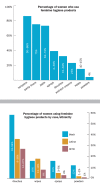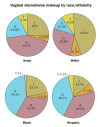A question for women's health: chemicals in feminine hygiene products and personal lubricants - PubMed (original) (raw)
A question for women's health: chemicals in feminine hygiene products and personal lubricants
Wendee Nicole. Environ Health Perspect. 2014 Mar.
No abstract available
Figures
Mucous membranes in the vagina and vulva rapidly absorb chemicals without metabolizing them. But until recently scant research existed on how chemicals in feminine hygiene products and personal lubricants may affect women’s health. © Roy Scott
Surveys conducted in the 1990s–2000s gave a sense not only of how commonly some products are used but also how widely use can vary across racial/ethnic groups. Adapted from Scranton (2013)
A study of the vaginal microbiomes of nearly 400 healthy women identified five major groups of microbial communities (groups I–V) that appeared in different proportions by ethnicity. Groups I, II, III, and V were dominated by Lactobacillus species, which are thought to play important protective roles in vaginal health. Group IV included a diversity of anaerobic species such as Prevotella and Gardnerella. Compared with white and Asian women, Hispanic and black women tended to have more group IV communities and higher vaginal pH values. The authors suggest that genetics and hygiene behaviors are just two factors that could account for the differences in microbiomes between ethnic groups. Reproduced with permission from Proceedings of the National Academy of Sciences
Comment in
- Changing trends in phthalate exposures.
Lioy PJ, Gennings C, Hauser R, Koch HM, Kortenkamp A. Lioy PJ, et al. Environ Health Perspect. 2014 Oct;122(10):A264. doi: 10.1289/ehp.1408629. Environ Health Perspect. 2014. PMID: 25272327 Free PMC article. No abstract available.
Similar articles
- Changing trends in phthalate exposures.
Lioy PJ, Gennings C, Hauser R, Koch HM, Kortenkamp A. Lioy PJ, et al. Environ Health Perspect. 2014 Oct;122(10):A264. doi: 10.1289/ehp.1408629. Environ Health Perspect. 2014. PMID: 25272327 Free PMC article. No abstract available. - Changing trends in phthalate exposures: Zota and Woodruff respond.
Zota AR, Woodruff TJ. Zota AR, et al. Environ Health Perspect. 2014 Oct;122(10):A264-5. doi: 10.1289/ehp.1408629R. Environ Health Perspect. 2014. PMID: 25271395 Free PMC article. No abstract available. - Over-the-counter treatments and perineal hygiene in postmenopausal women.
Erekson EA, Martin DK, Brousseau EC, Yip SO, Fried TR. Erekson EA, et al. Menopause. 2014 Mar;21(3):281-5. doi: 10.1097/GME.0b013e31829a3216. Menopause. 2014. PMID: 23880795 Free PMC article. - Role of female intimate hygiene in vulvovaginal health: Global hygiene practices and product usage.
Chen Y, Bruning E, Rubino J, Eder SE. Chen Y, et al. Womens Health (Lond). 2017 Dec;13(3):58-67. doi: 10.1177/1745505717731011. Epub 2017 Sep 22. Womens Health (Lond). 2017. PMID: 28934912 Free PMC article. Review. - A behind-the-scenes look at the safety assessment of feminine hygiene pads.
Farage MA. Farage MA. Ann N Y Acad Sci. 2006 Dec;1092:66-77. doi: 10.1196/annals.1365.006. Ann N Y Acad Sci. 2006. PMID: 17308134 Review.
Cited by
- Recurrent Vulvovaginal Candidiasis: Assessing the relationship between feminine/vaginal washes and other factors among Ghanaian women.
Otoo-Annan E, Senoo-Dogbey VE. Otoo-Annan E, et al. BMC Public Health. 2024 Jan 5;24(1):100. doi: 10.1186/s12889-024-17668-x. BMC Public Health. 2024. PMID: 38183091 Free PMC article. - The Vaginal Microbiome in Health and Disease-What Role Do Common Intimate Hygiene Practices Play?
Holdcroft AM, Ireland DJ, Payne MS. Holdcroft AM, et al. Microorganisms. 2023 Jan 23;11(2):298. doi: 10.3390/microorganisms11020298. Microorganisms. 2023. PMID: 36838262 Free PMC article. Review. - Phthalates and Incident Diabetes in Midlife Women: The Study of Women's Health Across the Nation (SWAN).
Peng MQ, Karvonen-Gutierrez CA, Herman WH, Mukherjee B, Park SK. Peng MQ, et al. J Clin Endocrinol Metab. 2023 Jul 14;108(8):1947-1957. doi: 10.1210/clinem/dgad033. J Clin Endocrinol Metab. 2023. PMID: 36752637 Free PMC article. - Personal care product use among diverse women in California: Taking Stock Study.
Dodson RE, Cardona B, Zota AR, Robinson Flint J, Navarro S, Shamasunder B. Dodson RE, et al. J Expo Sci Environ Epidemiol. 2021 May;31(3):487-502. doi: 10.1038/s41370-021-00327-3. Epub 2021 May 6. J Expo Sci Environ Epidemiol. 2021. PMID: 33958707 - Use of Menstrual Sanitary Products in Women of Reproductive Age: Korea Nurses' Health Study.
Choi H, Lim NK, Jung H, Kim O, Park HY. Choi H, et al. Osong Public Health Res Perspect. 2021 Feb;12(1):20-28. doi: 10.24171/j.phrp.2021.12.1.04. Osong Public Health Res Perspect. 2021. PMID: 33659151 Free PMC article.
References
- Euromonitor International. Country Report: Sanitary Protection in the US. London, UK:Euromonitor International (June 2013). Available: http://www.euromonitor.com/sanitary-protection-in-the-us/report [accessed 24 January 2104].
- Scranton A. Chem Fatale: Potential Health Effects of Toxic Chemicals in Feminine Care Products. Missoula, MT:Women’s Voices for the Earth (November 2013). Available: http://goo.gl/BgIwdu [accessed 24 January 2014].
- H.R. 2332 (112th Congress): Robin Danielson Act. Available: http://thomas.loc.gov/cgi-bin/query/z?c112:H.R.2332: [accessed 24 January 2014].
Publication types
MeSH terms
Substances
LinkOut - more resources
Full Text Sources
Other Literature Sources
Medical


